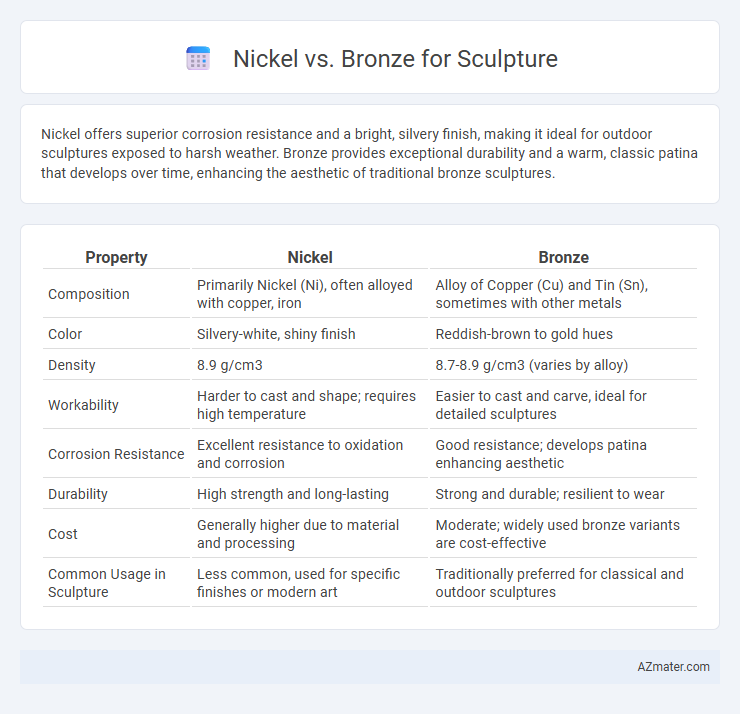Nickel offers superior corrosion resistance and a bright, silvery finish, making it ideal for outdoor sculptures exposed to harsh weather. Bronze provides exceptional durability and a warm, classic patina that develops over time, enhancing the aesthetic of traditional bronze sculptures.
Table of Comparison
| Property | Nickel | Bronze |
|---|---|---|
| Composition | Primarily Nickel (Ni), often alloyed with copper, iron | Alloy of Copper (Cu) and Tin (Sn), sometimes with other metals |
| Color | Silvery-white, shiny finish | Reddish-brown to gold hues |
| Density | 8.9 g/cm3 | 8.7-8.9 g/cm3 (varies by alloy) |
| Workability | Harder to cast and shape; requires high temperature | Easier to cast and carve, ideal for detailed sculptures |
| Corrosion Resistance | Excellent resistance to oxidation and corrosion | Good resistance; develops patina enhancing aesthetic |
| Durability | High strength and long-lasting | Strong and durable; resilient to wear |
| Cost | Generally higher due to material and processing | Moderate; widely used bronze variants are cost-effective |
| Common Usage in Sculpture | Less common, used for specific finishes or modern art | Traditionally preferred for classical and outdoor sculptures |
Introduction to Sculpture Materials
Nickel and bronze are prominent materials in sculpture due to their durability and aesthetic qualities. Bronze, an alloy of copper and tin, offers excellent corrosion resistance and a warm, classic patina favored in traditional sculptures. Nickel, often used in plating or alloyed with other metals, provides a bright, silvery finish with superior hardness but is less common alone in sculptural works compared to bronze.
Overview of Nickel and Bronze
Nickel is a corrosion-resistant metal known for its silvery-white appearance and excellent durability, making it suitable for detailed sculptures requiring long-term preservation. Bronze, an alloy primarily composed of copper and tin, has been a traditional choice for sculpture due to its strength, workability, and rich, warm patina that develops over time. While nickel offers a modern aesthetic with high resistance to oxidation, bronze provides a classic, timeless quality favored for large-scale and historic sculptural works.
Historical Use in Sculpture
Bronze has been the preferred material for sculptures since ancient times, notably used by civilizations such as the Greeks and Romans for its durability and ability to capture fine details through the lost-wax casting process. Nickel, though historically less common, gained popularity in the 19th and 20th centuries for its corrosion resistance and sleek, modern appearance, but it lacked the traditional warmth and patina characteristic of bronze sculptures. The longstanding tradition of bronze sculpting is deeply rooted in cultural heritage, while nickel's use remains more experimental and limited in historical artistic contexts.
Physical Properties Comparison
Nickel exhibits higher tensile strength and corrosion resistance compared to bronze, making it more durable for outdoor sculptures. Bronze, an alloy primarily of copper and tin, offers excellent malleability and a warm, rich patina that develops over time, enhancing its aesthetic appeal. The density of nickel (8.9 g/cm3) is slightly higher than bronze (approximately 8.7 g/cm3), impacting the sculpture's weight and structural support requirements.
Durability and Longevity
Nickel offers superior corrosion resistance compared to bronze, making it more durable in harsh environments and less prone to tarnishing or oxidation over time. Bronze, an alloy of copper and tin, develops a protective patina that enhances its longevity but requires regular maintenance to prevent deterioration. Sculptors seeking long-lasting outdoor installations often prefer nickel for its robustness and minimal upkeep requirements.
Aesthetic Qualities and Finishes
Nickel offers a bright, reflective finish with a silvery-white hue that enhances modern, sleek sculptures, while bronze presents a warm, earthy tone with deep reddish and golden highlights, ideal for classical and timeless works. Bronze develops a natural patina over time, adding depth and character, whereas nickel retains its shine but may require polishing to prevent tarnish. Both metals provide distinct aesthetic qualities, with bronze favored for its historic appeal and nickel prized for its contemporary brilliance.
Workability and Casting Techniques
Nickel offers superior corrosion resistance and hardness, making it more durable but challenging to work with due to its higher melting point and resistance to deformation. Bronze, an alloy primarily of copper and tin, is favored for sculpture casting because of its excellent fluidity and lower melting point, enabling intricate details and easier manipulation during lost-wax casting processes. The workability of bronze allows for smoother finishes and finer textures, while nickel requires advanced casting techniques and often specialized equipment to achieve comparable results.
Cost and Availability
Nickel alloys typically cost more than bronze due to the higher price of raw nickel and the complex refining process required. Bronze, composed mainly of copper and tin, has been widely available and economically feasible for centuries, making it a preferred choice for large-scale sculptures. The consistent global supply and lower cost of bronze enable artists and manufacturers to produce sculptures with budget efficiency and material reliability.
Environmental Impact and Sustainability
Nickel and bronze differ significantly in environmental impact and sustainability for sculpture use. Nickel mining often involves intensive energy consumption and toxic byproducts, raising concerns about soil and water contamination. Bronze, an alloy primarily of copper and tin, generally has a lower environmental footprint due to more established recycling practices and longer material lifespan, making it a more sustainable choice for sculptors prioritizing eco-friendly materials.
Choosing the Right Material for Your Sculpture
Nickel offers exceptional corrosion resistance and a sleek, modern finish ideal for outdoor sculptures exposed to harsh environments. Bronze provides timeless durability with rich patina development, enhancing the sculpture's aesthetic appeal over time. Selecting between nickel and bronze depends on the desired visual effect, environmental exposure, and long-term maintenance considerations for your sculpture.

Infographic: Nickel vs Bronze for Sculpture
 azmater.com
azmater.com